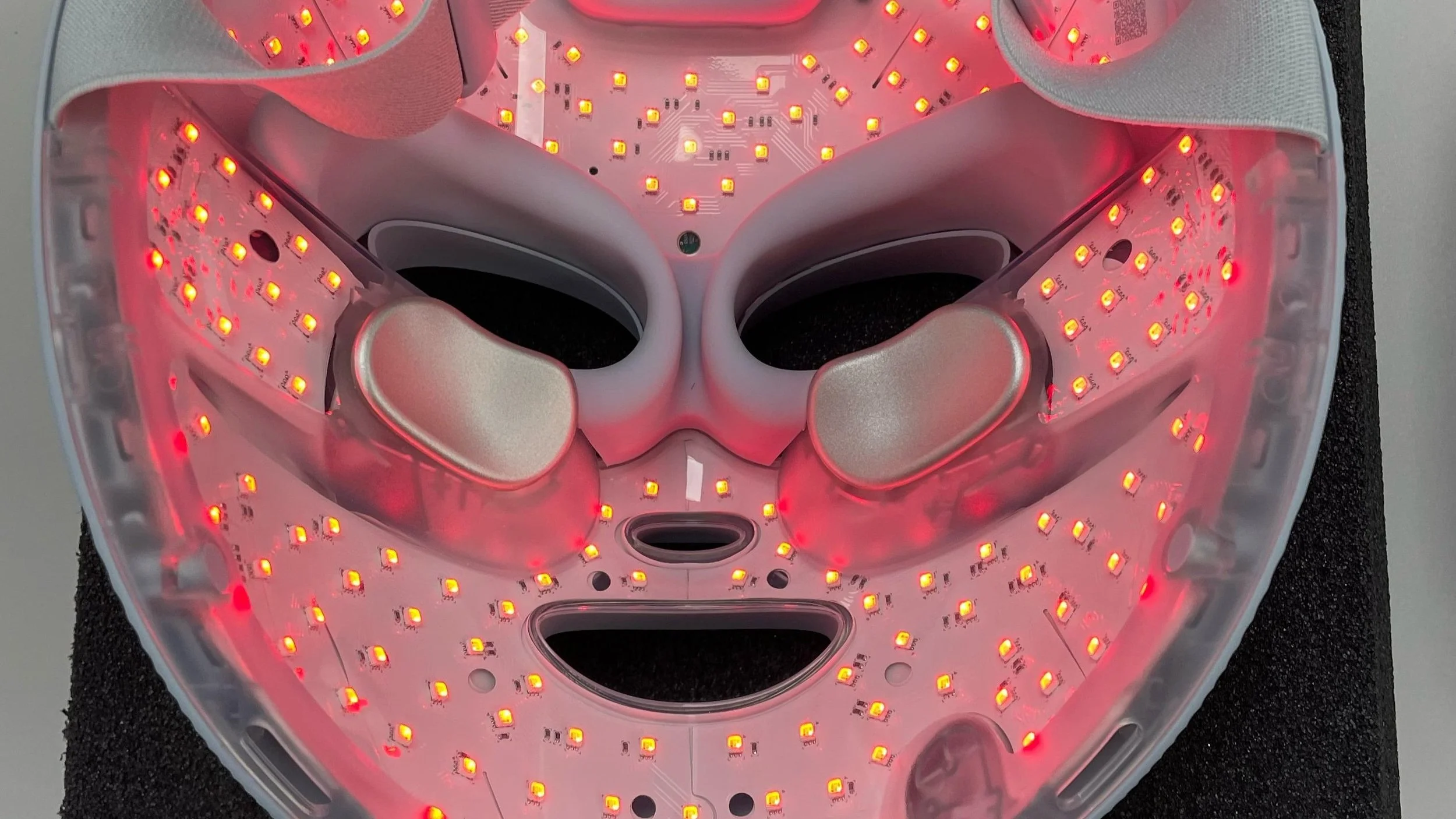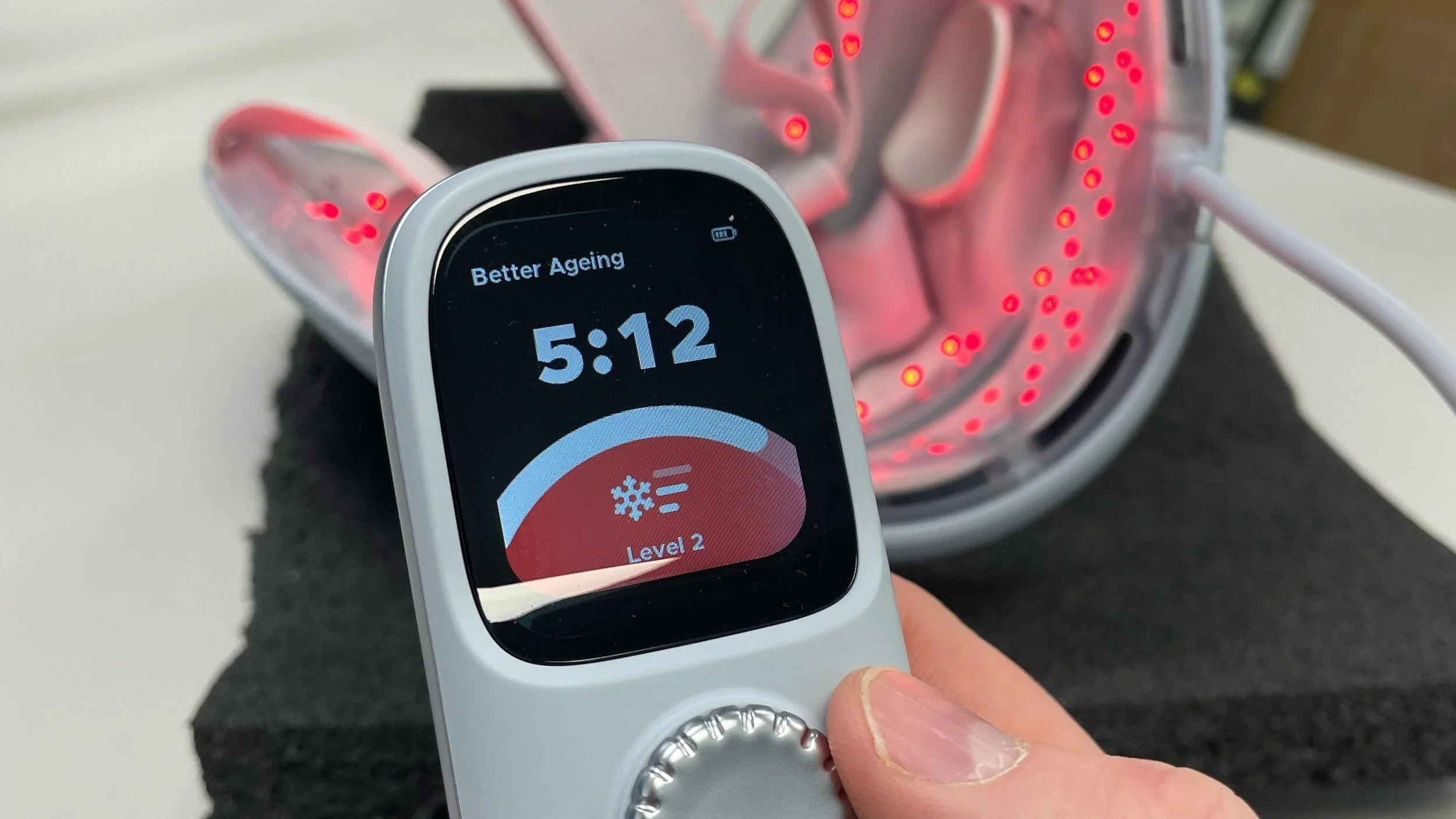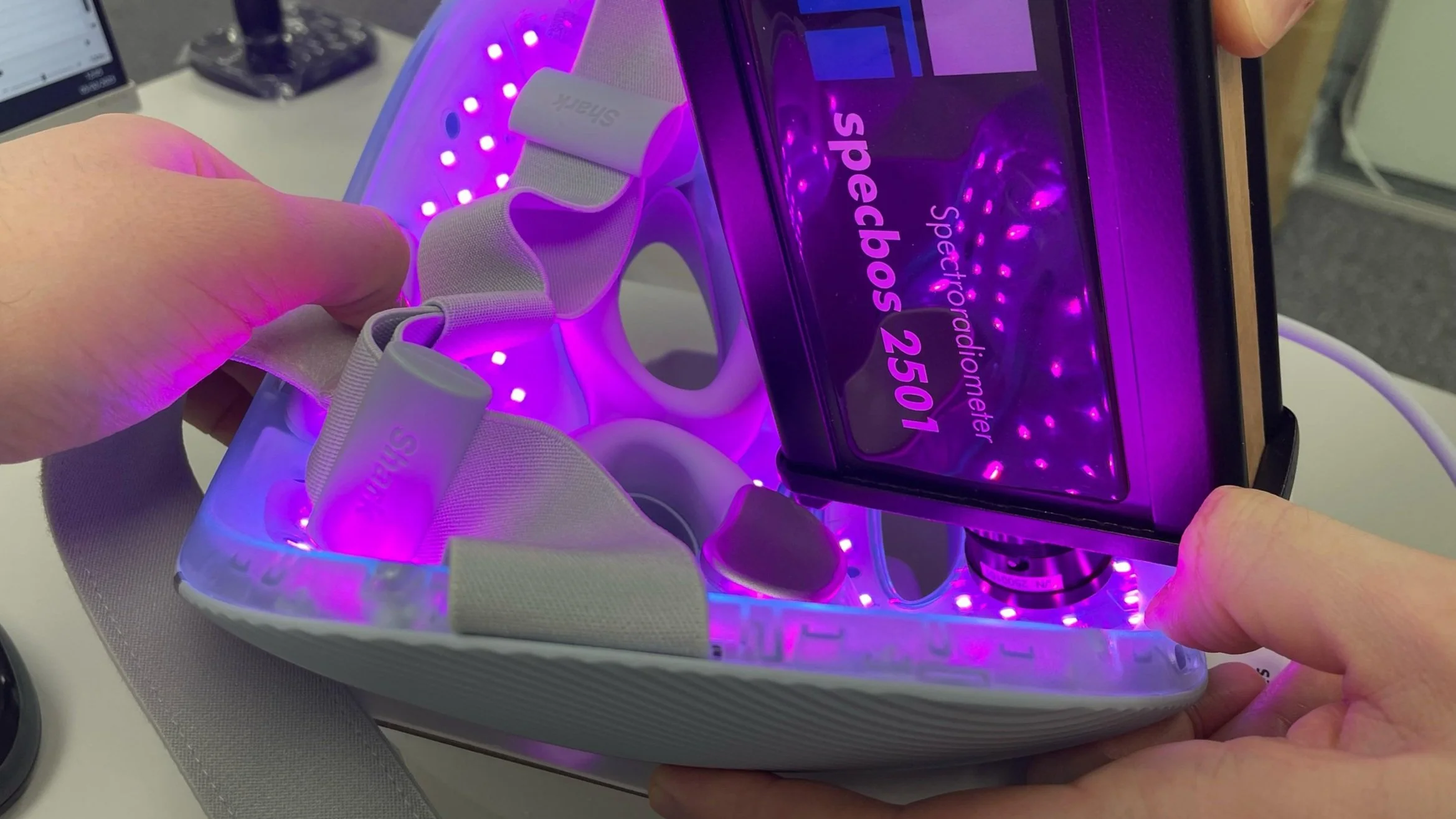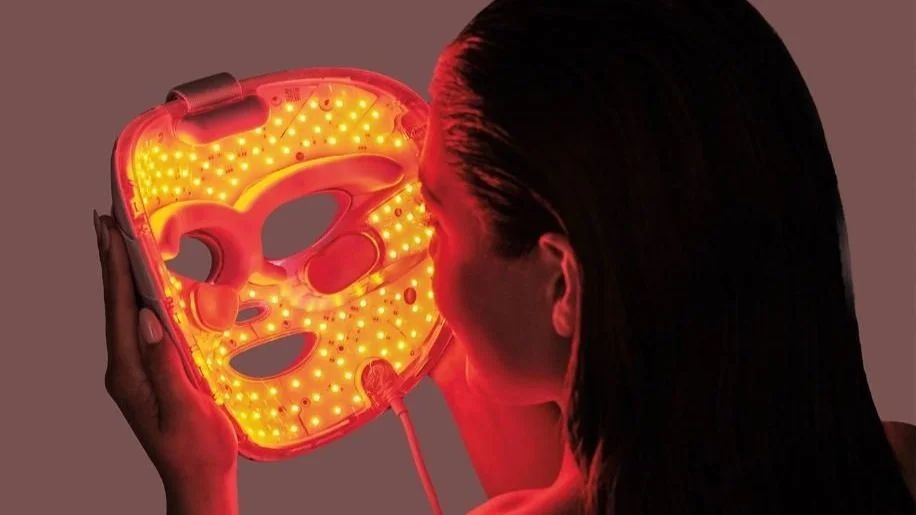In November 2024, SharkNinja, known for its engineering expertise in home appliances, entered the beauty tech space with the Shark CryoGlow LED Face Mask—a device that combines LED therapy with under-eye cooling. As the first major brand to launch an LED mask, it quickly sparked a surge in consumer interest, with Google searches for LED face masks rising significantly after its release.
A few weeks ago, I tested the Shark CryoGlow LED Face Mask to see if it lives up to the hype. This review dives into its industrial design, functionality, treatment protocols, and—most importantly—its LED performance. Does it deliver on its claims? Let’s find out.
Industrial Design & Usability
Right out of the box, the Shark CryoGlow LED Face Mask feels exceptionally well-built. The plastic injection molding has a consistently high-quality finish, with no visible imperfections—something that immediately sets it apart from cheaper alternatives on the market.
Despite its solid construction, the mask is surprisingly comfortable. While it has some weight, it's distributed well, making it easy to wear for a full session without discomfort. Like most LED masks, it does have a somewhat intimidating, futuristic look, but compared to many others, it’s one of the more refined designs.
The head strap is simple but effective, preventing the mask from slipping—a frustrating issue with standard silicone masks that many brands fail to address. The controller is equally robust, and the UI is intuitive and easy to navigate, making operation straightforward even for first-time users. A particularly clever touch is the LED dimming function, which prevents the lights from blinding you when putting the mask on or taking it off.
However, the biggest design flaw lies in light coverage. While Shark has focused on comfort, it comes at the expense of LED exposure to key treatment areas. The cryo pads block light from reaching large portions of the under-eye and cheek area, while the eye guard pads completely obstruct the glabella (stress lines between the brows). Additionally, the crow’s feet region gets minimal exposure—all of which are common concern areas for those using the mask for anti-aging.
In summary, the Shark CryoGlow LED Mask is exceptionally well-built, robust, and clearly designed with the user in mind at every stage. However, for a device intended for LED therapy, blocking so many key treatment areas is a significant flaw.
Treatment Protocols
The Shark CryoGlow LED Mask uses 415nm (blue), 630nm (red), and 830nm (NIR)—clinically backed wavelengths, similar to those in Dermalux devices. While well-selected, their combinations in the treatment modes could be better optimised.
Better Aging (Red + NIR, 6 mins) – A solid protocol for collagen stimulation and inflammation reduction. Red and NIR are well-paired for skin rejuvenation.
Blemish Repair (Multi-step Red, Blue & NIR) – A step-based approach to acne, though it should emphasise blue and NIR more, as blue targets bacteria while NIR reduces inflammation.
Skin Sustain (Red, Blue & NIR, 4 mins) – This mix feels misaligned. Blue light reduces mitochondrial function, while red and NIR stimulate it—potentially limiting its effectiveness. Blue should be reserved for antibacterial use rather than combined in a general skin-health mode.
One major issue is that all treatment times are extremely short. As testing will show later, this isn’t due to high power output—the total energy delivered is low. I feel like this is sub-optimal and likely dictated by battery capacity concerns, especially when running the cryo element.
There also feels like there is a missed opportunity to combine the cryo element with a higher amount NIR to create a anti-inflammatory protocol which could have been effective.
Cryo Pad Function
I’m not an expert in cryo technology, so I’ll keep this brief—but the cooling effect is genuinely impressive. The Peltier-based cryo pads chill rapidly and feel refreshing and rejuvenating, making them great for early morning use to wake up the skin and reduce tired eyes. Unlike many add-ons in beauty tech, this isn’t a gimmick—it adds real functionality.
Cryotherapy is known for reducing puffiness and calming inflammation, so its inclusion makes sense. However, the pads cover large areas, blocking LED exposure to key treatment zones like the under-eyes and glabella. They’re also power-intensive, which likely contributes to the short treatment times—a worthwhile trade-off for cooling benefits, but not ideal for maximising LED coverage.
LED Performance & Testing
To properly assess the Shark CryoGlow LED Mask, I tested all three treatment modes using a Jeti Specbos 2501 spectroradiometer, which was calibrated in September 2024. It’s common for LED masks to show strong output directly above the LEDs but much weaker power between them, so I was particularly interested in how evenly the mask distributes light.
Since the mask sits around 16mm away from the skin when worn, I took readings both at the surface of the plastic and at this realistic wear distance to measure the actual irradiance reaching the skin.
Irradiance Measurements:
| Stated Wavelength | Measured Peak Wavelength | Surface (0mm) | 16mm Distance |
|---|---|---|---|
| Red (630nm) | 627nm | 6.9 mw/cm² | 2.1 mw/cm² |
| NIR (830nm) | 828nm | 5.5 mw/cm² | 1.9 mw/cm² |
| Blue (415nm) | 414nm | 6.0 mw/cm² | 2.18 mw/cm² |
One positive finding was that light distribution across the mask was even, with minimal difference between measurements directly above the LEDs and between them. This suggests the design ensures consistent exposure across the skin, which is something many LED masks fail to achieve.
In terms of wavelength accuracy, the mask performed well. The peak wavelengths were close to their targets, and the FWHM (full width at half maximum) readings were relatively tight, indicating good spectral purity. However, this is easier to achieve when operating at low power levels, which is the case here.
Total Energy Density (J/cm²) Over Treatment Time:
| Treatment Protocol | Surface (0mm) | 16mm Distance |
|---|---|---|
| Better Aging | 4.46 J/cm² | 1.44 J/cm² |
| Skin Sustain | 2.92 J/cm² | 1.08 J/cm² |
| Blemish Repair | Not possible to calculate an exact energy dose due to the treatment being delivered in three phases. | |
Despite the solid spectral accuracy, the total energy delivered over time is very low. For example, at the realistic 16mm distance, the Better Aging protocol only delivers 1.44J/cm², significantly less than what’s typically required for effective LED therapy.
Shark claims the mask outputs up to 73mW/cm² per wavelength and 128mW/cm² when combined, but my testing didn’t come close to these numbers.
I don’t believe this points to dishonesty from Shark, but rather highlights the lack of standardisation in LED phototherapy measurements. The industry often misleads consumers by failing to clarify testing conditions, distance from the skin, and total energy delivered—all of which are crucial for real-world effectiveness.
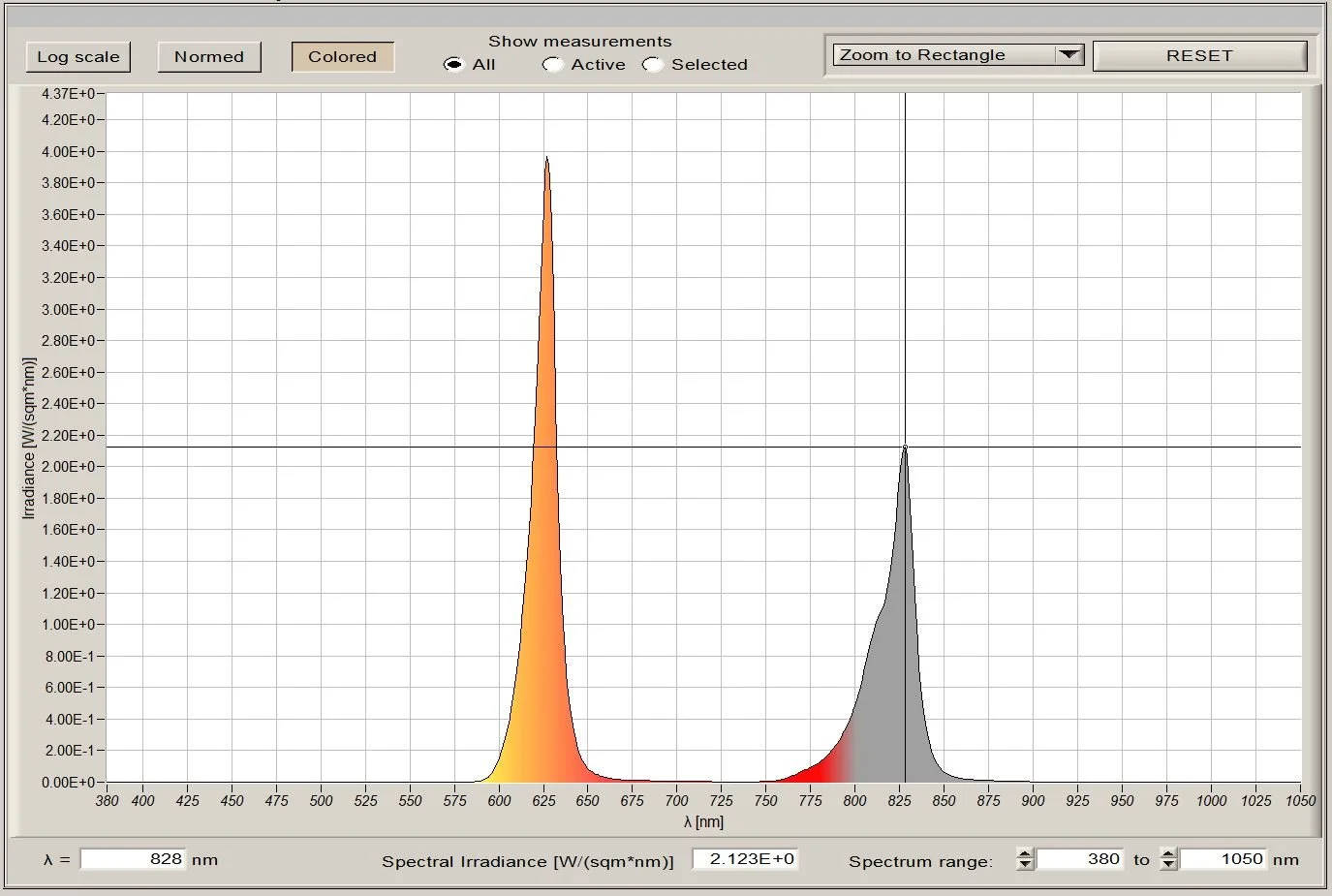







A Note on Energy Density Claims
One of the biggest challenges in the LED mask industry is the lack of standardisation in how energy density is reported. Some brands, including Shark, claim extremely high J/cm² figures, with Shark stating the CryoGlow Mask can deliver up to 431.4 J/cm² for Red + NIR. However, these numbers can be misleading if they refer to the total cumulative output of all LEDs combined, rather than the actual dose delivered to each cm² of skin.
To put this into perspective, 431.4 J/cm² would make it nearly twice as powerful as the Dermalux TriWave MD, a medical-grade LED system used in professional clinics—a claim that simply doesn’t hold up under real-world testing.
Energy density should be measured at a realistic wear distance—in this case, 16mm away from the mask’s surface. My testing shows that the Better Aging protocol delivers just 1.44 J/cm² at this distance, a staggering difference from Shark’s claim. This highlights a widespread issue in the industry, where figures are often presented in ways that inflate perceived performance. Without clear, industry-wide standards, consumers are often misled into believing they are receiving significantly more light energy than they actually are.
Pros & Cons
Pros:
Exceptional build quality – robust plastic injection moulding with a flawless finish.
Comfortable to wear – well-balanced weight distribution and secure strap.
Cryo pads work well – effective for reducing puffiness and refreshing the skin, great for morning use.
Even light distribution – minimal drop-off between LEDs, ensuring consistent exposure.
Intuitive controls – simple UI and a useful LED dimming function to prevent glare.
Cons:
Blocked treatment areas – cryo pads and eye guards completely block light from key anti-ageing zones like the under-eyes, crow’s feet, and glabella.
Underpowered LEDs – significantly lower irradiance and energy delivery than claimed.
Very short treatment times – likely limited by battery constraints rather than therapeutic efficacy.
Marketing claims don’t match real-world performance – Shark states 431 J/cm², yet real-world dosing is less than 1.5 J/cm² at a realistic wear distance.
Questionable protocol design – combining blue light with red and NIR in ‘Skin Sustain’ mode may reduce its effectiveness.
Verdict – Would I Buy It?
The Shark CryoGlow LED Mask does a lot of things right. Power isn’t everything, and with the home-use LED market flooded with exaggerated power claims, it’s refreshing to see a device with accurate wavelengths and well-distributed light—both major positives. The build quality is excellent, the cryo function adds real value, and the user experience is well thought out.
Despite its flaws, I would consider buying one purely because it is so well manufactured and engineered—it feels like a premium product. However, the lack of power is a major drawback, and for those wanting a truly effective LED treatment, there are better-performing options on the market.
Final Thoughts
While the Shark CryoGlow LED Mask may not deliver the power levels needed for truly optimal LED therapy, its exceptional build quality, thoughtful design, and well-executed features set a new standard for home-use LED devices. In an industry filled with cheap, poorly designed masks and misleading power claims, this product is pushing things in the right direction. Hopefully, we’ll see more brands following Shark’s lead—bringing the same level of engineering excellence and design care to the next generation of LED masks, while also focusing on delivering the power and treatment efficacy that truly makes a difference.
